It looks like you're using an Ad Blocker.
Please white-list or disable AboveTopSecret.com in your ad-blocking tool.
Thank you.
Some features of ATS will be disabled while you continue to use an ad-blocker.
share:
reply to post by eriktheawful
Those are fairly large planetary bodies (well two of them), right? Scale is everything when you are comparing those objects with the far smaller mass of most comets we know of. Would you like to estimate the relative diameters of those planetary objects top and bottom in your posts (no idea about the centre image) with the diameters of these actual comets I include below?
Tempel 1 - Instant the impactor spacecraft hits the comet. The photo taken by high resolution camera on Deep Impact.

www.nasa.gov...
Tempel 1 - Impact before and after shots. Look for the DST predicted deep hole in the ice. It is nothing but a shallow crater predicted by EC because comets are solid bodies. They are not composites of icy and bits of space junk.
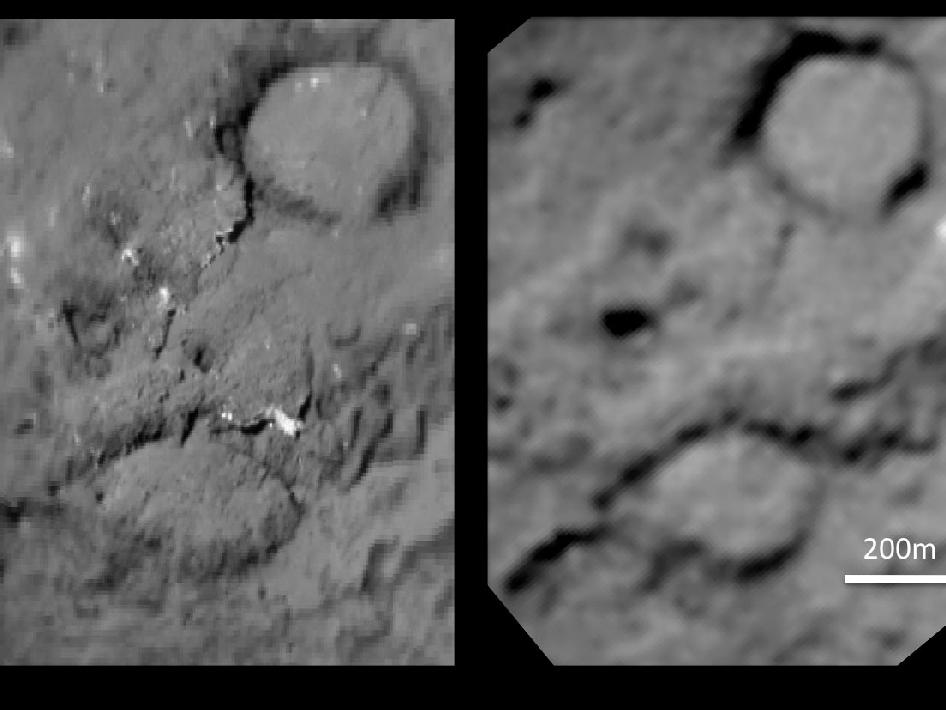
Also very good is this view of the comet.
stardust.jpl.nasa.gov...
Notice in these high resolution images of comet surfaces the shallow bottomed craters suggesting the comet is a solid body, not one that is composed of some mix of hard materials and frozen water. Notice the complete and utter lack of any vents. Can you actually see any?
Here is comet Hartely 2. There is obviously some flaring going on. But is it vented dust and gases? Where are the vents? It is a bit far a way to be certain I admitt, but consider this. If it were sublimated icy material from the nucleus vented through the surface as a result of the Sun - as DST has attempts to explain it - then why is there flaring on the side not facing the sun?
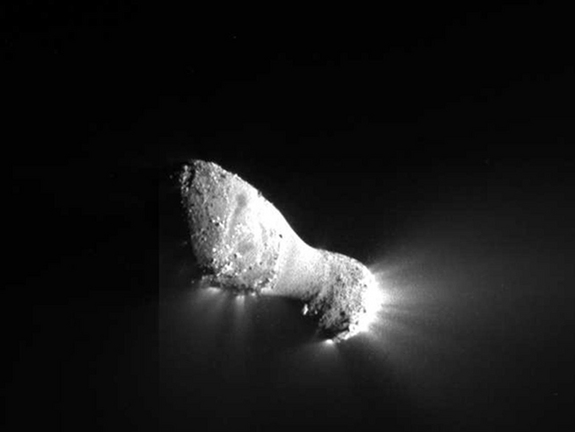
Here is what the EC model has to say about the venting we see.
www.thunderbolts.info...
Take a look at these images and tell me which ones are made up mostly of ice, and which ones are not:
Those are fairly large planetary bodies (well two of them), right? Scale is everything when you are comparing those objects with the far smaller mass of most comets we know of. Would you like to estimate the relative diameters of those planetary objects top and bottom in your posts (no idea about the centre image) with the diameters of these actual comets I include below?
Tempel 1 - Instant the impactor spacecraft hits the comet. The photo taken by high resolution camera on Deep Impact.

www.nasa.gov...
Tempel 1 - Impact before and after shots. Look for the DST predicted deep hole in the ice. It is nothing but a shallow crater predicted by EC because comets are solid bodies. They are not composites of icy and bits of space junk.

Also very good is this view of the comet.
stardust.jpl.nasa.gov...
Notice in these high resolution images of comet surfaces the shallow bottomed craters suggesting the comet is a solid body, not one that is composed of some mix of hard materials and frozen water. Notice the complete and utter lack of any vents. Can you actually see any?
Here is comet Hartely 2. There is obviously some flaring going on. But is it vented dust and gases? Where are the vents? It is a bit far a way to be certain I admitt, but consider this. If it were sublimated icy material from the nucleus vented through the surface as a result of the Sun - as DST has attempts to explain it - then why is there flaring on the side not facing the sun?

Here is what the EC model has to say about the venting we see.
Supersonic jets have been seen exploding from comets' nuclei. From the mainstream perspective, these jets are eruptions of subsurface gas and water from solar heating. But again and again, this theory has been refuted by observation. In the case of Comet Wild 2, some of its nearly two dozen jets emanated from the dark, unheated side of the comet. And as seems to be the case with most comet jets, they remained intact across great distances -- they did not disperse in the fashion of a gas in a vacuum (an anomaly left unresolved, and not even addressed by most mainstream theorists). Consider also the jets of comet Hale-Bopp, which began discharging (seven jets) while it was still too far from the Sun for a "snowball" to melt.
…
From the Electric Universe perspective, comet jets arise from the interaction between the electric charge of the comet and the solar discharge plasma. The comet spends most of its time far from the Sun, where the plasma charge density is low. The comet moves slowly and its charge easily comes into balance with that region. On the other hand, as the comet approaches the Sun, the nucleus moves at a furious speed through regions of increasing charge density and varying electrical characteristics. The comet's surface charge and internal polarization, developed in deep space, respond to the new environment by forming cathode jets and a visible plasma sheath, or coma. The jets flare up and move over the nucleus irregularly, and the comet may shed and grow anew several tails. Or the comet may explode like an overstressed capacitor (see below), breaking into separate fragments or simply giving up the ghost and disappearing.
Cometary discharging may also occur due to any disturbances of its electrical plasma sheath as it passes through regions of varying electric potential. This seems to have occurred in the recent "totally surprising" outburst of Comet Holmes 17P as it moved away from the Sun's domain.
www.thunderbolts.info...
edit on 21-11-2013 by Tallone because: (no reason given)
reply to post by OccamsRazor04
REALLY???
Come on dude, I already said that what....3 times now?
I AGREE WITH YOUR ASSESSMENT THAT THE CURRENT DATA SHOWS THAT THE SOLAR WIND IS NET NEUTRAL.
That is all it shows! Hence where we started talking about scale, and you went on to say scale is not relevant, and I was like...Oh hey quantum theory.... you know you said to stop talking etc?
Just because something is charge neutral does not mean it can't conduct electricity.
Straight from wiki bro.
So why does it matter if the solar wind is net neutral again? MAN, this thread is HOT!
.... you clearly have little to no understanding. I suggest you do some reading on whether solar winds are positively charged, and stick to actual science. Then feel free to post sources that show solar winds are positively charged.
REALLY???
Come on dude, I already said that what....3 times now?
I AGREE WITH YOUR ASSESSMENT THAT THE CURRENT DATA SHOWS THAT THE SOLAR WIND IS NET NEUTRAL.
That is all it shows! Hence where we started talking about scale, and you went on to say scale is not relevant, and I was like...Oh hey quantum theory.... you know you said to stop talking etc?
Just because something is charge neutral does not mean it can't conduct electricity.
Since plasmas are very good electrical conductors, electric potentials play an important role. The potential as it exists on average in the space between charged particles, independent of the question of how it can be measured, is called the "plasma potential", or the "space potential". If an electrode is inserted into a plasma, its potential will generally lie considerably below the plasma potential due to what is termed a Debye sheath. The good electrical conductivity of plasmas makes their electric fields very small. This results in the important concept of "quasineutrality", which says the density of negative charges is approximately equal to the density of positive charges over large volumes of the plasma (ne = ni), but on the scale of the Debye length there can be charge imbalance. In the special case that double layers are formed, the charge separation can extend some tens of Debye lengths.
Straight from wiki bro.
So why does it matter if the solar wind is net neutral again? MAN, this thread is HOT!
edit on 21-11-2013 by vind21 because: (no reason
given)
reply to post by Tallone
Well I have posted facts and actual observed data that supports the DST model. Anyone interested can go to NASA and look at the Deep Impact experiments. Other than that, I wish you guys the best. It's impossible to speak to someone who is covering their ears.
Well I have posted facts and actual observed data that supports the DST model. Anyone interested can go to NASA and look at the Deep Impact experiments. Other than that, I wish you guys the best. It's impossible to speak to someone who is covering their ears.
Tallone
There you go. Think about it. Why are these icy planetary bodies not burnt dry by the sun. They should have sublimated away to next to nothing by now. A whole lotta sublimation should be observed don't you think? Since that is what DST is telling us goes on as soon as a dirty snowball travels past Jupiter toward the Sun.
So what you appear to be saying that according to the DST theory, each orbital pass around the sun should remove material from the comet and make it smaller each time?
Interesting theory.
Turns out to be true.
Taking Encke's comet as a good example where multiple returns have been observed and much data is available, here's what comet specialist Seiichi Yoshida says:
However, the brightness of the comet has been declining. At its discovery in early 19th century, it was brighter than now by 4 mag. It reached to 3.5 mag at best and visible as bright as Andromeda Galaxy with naked eyes. Now it reaches to 6.5-7 mag at best.
reply to post by eriktheawful
Hmmm. "a one in a billion coincidence"?
Read the quote from NASA then watch the video embedded below.
On September 21 NASA scrapped the Deep Impact project.
www.universetoday.com...
Apparently because it is now orbiting the Sun as space junk, or…is it?
This is a very interesting video.
Here it is then, with no further comment.
Deep Impact will not be taking any images of ISON ever again. The craft is defunct (it's stuck in reboot mode). It is also no where near ISON, nor will it be close to ISON again.
Hmmm. "a one in a billion coincidence"?
Read the quote from NASA then watch the video embedded below.
On September 21 NASA scrapped the Deep Impact project.
Disappointing news today from Dr. Mike A’Hearn, Principal Investigator of the EPOXI mission, which has been using the repurposed spacecraft from the Deep Impact mission to study comets. The spacecraft was going to take some much-anticipated images of Comet ISON, but apparently a communication problem has occurred and the images may have been lost or possibly never taken.
www.universetoday.com...
Apparently because it is now orbiting the Sun as space junk, or…is it?
This is a very interesting video.
Here it is then, with no further comment.
reply to post by alfa1
I edited that post a little earlier.
Because the images were not labeled by the poster there was nothing I could say about them, and definitely I couldn't use them in an argument not knowing what exactly they were. The text you quoted is gone.
I edited that post a little earlier.
Because the images were not labeled by the poster there was nothing I could say about them, and definitely I couldn't use them in an argument not knowing what exactly they were. The text you quoted is gone.
reply to post by Tallone
How is what you're claiming now any different than people claiming WISE's shutdown was proof that Elenin was actually Nibiru? Space is the harshest of environments and these satellites are going to breakdown sooner or later.
How is what you're claiming now any different than people claiming WISE's shutdown was proof that Elenin was actually Nibiru? Space is the harshest of environments and these satellites are going to breakdown sooner or later.
reply to post by Tallone
I thought the thread was about EU theory, with C/2012 S1 being proof of that theory?
Or is it about very high speculation of a government cover-up?
I could sit here and say that it wasn't the government shutting down DI to avoid any high detailed images of C/2012 S1 being released to the public, somehow proving EU theory, but instead it was actually destroyed by aliens because of space craft they have hiding in it's coma.
My highly speculative statement above is just as valid as yours. However, both subjects belong in Skunk Works, being so outrageously speculative, with absolutely no proof to back either statement up.
So what is your thread about? EU Theory and how it relates to C/2012 S1? Or about secret NASA government cover-up of C/2012 S1?
Please clarify so the mods on here will know whether to leave the thread where it is (scientific discussion, even theoretical discussions) or move it to a more proper place (highly speculative discussions, requiring no proof, IE Skunk Works).
I thought the thread was about EU theory, with C/2012 S1 being proof of that theory?
Or is it about very high speculation of a government cover-up?
I could sit here and say that it wasn't the government shutting down DI to avoid any high detailed images of C/2012 S1 being released to the public, somehow proving EU theory, but instead it was actually destroyed by aliens because of space craft they have hiding in it's coma.
My highly speculative statement above is just as valid as yours. However, both subjects belong in Skunk Works, being so outrageously speculative, with absolutely no proof to back either statement up.
So what is your thread about? EU Theory and how it relates to C/2012 S1? Or about secret NASA government cover-up of C/2012 S1?
Please clarify so the mods on here will know whether to leave the thread where it is (scientific discussion, even theoretical discussions) or move it to a more proper place (highly speculative discussions, requiring no proof, IE Skunk Works).
reply to post by eriktheawful
I think that decent points where made by many people. It would probably be more efficient if further discussion about any particular main points be brought up in their own respective threads.
Where ever this thread ends up, it does have a nice collection of data.
I think that decent points where made by many people. It would probably be more efficient if further discussion about any particular main points be brought up in their own respective threads.
Where ever this thread ends up, it does have a nice collection of data.
reply to post by eriktheawful
Could you outline which particular posts don't fall in the scientific discussion or theoretical discussions realm.
Have you contacted a mod over your dilemma?
Please clarify so the mods on here will know whether to leave the thread where it is (scientific discussion, even theoretical discussions) or move it to a more proper place (highly speculative discussions, requiring no proof, IE Skunk Works).
Could you outline which particular posts don't fall in the scientific discussion or theoretical discussions realm.
Have you contacted a mod over your dilemma?
I have had to think twice before embedding these two videos on this thread. There is some speculative stuff here. But meh – yeah, what the heck. He
is one of the sharper bunch doing commentary on ISON, and yes that is EC driven commentary, so don’t go into anaphylactic shock when you realize
this, I have already told you beforehand. The guy has been wrong sometimes, but mostly he has been bang on correct, right since the first video he
posted on Youtube on the subject of ISON some 5 months ago.
Comet ISON and the Sun are interacting with each other. There has been 4 X class flares from the Sun in the direction of ISON in just as many days. Of the 4 flares 3 of these have been direct hits on ISON. There is reference to the other comet, Comet Encke that is travelling in the opposite direction, with and both in perihelion within a few days of each other. There is some blunt criticism dished out on some of the DST driven commentary on ISON.
Part 12a
The second video he rips into DST again with malevolent wit, and postulates not only that ISON is rotating but that it is round, and that it is at least as big as the Earth’s moon. I told you it was going to be a bit speculative. He is smart and he has been right on the money in his postings when the professional astronomers and respected amateurs have got it wrong. So take care where you plant your axe when you post in response, Eugene.
Part 12b
Comet ISON and the Sun are interacting with each other. There has been 4 X class flares from the Sun in the direction of ISON in just as many days. Of the 4 flares 3 of these have been direct hits on ISON. There is reference to the other comet, Comet Encke that is travelling in the opposite direction, with and both in perihelion within a few days of each other. There is some blunt criticism dished out on some of the DST driven commentary on ISON.
Part 12a
The second video he rips into DST again with malevolent wit, and postulates not only that ISON is rotating but that it is round, and that it is at least as big as the Earth’s moon. I told you it was going to be a bit speculative. He is smart and he has been right on the money in his postings when the professional astronomers and respected amateurs have got it wrong. So take care where you plant your axe when you post in response, Eugene.
Part 12b
edit on 21-11-2013 by Tallone because: Bought to my attention I missed out the 'X' in "4 X class flares" so I corrected that.
reply to post by vind21
Yeah. You say it bang on.
Very pleasing to have that posted.
vind21
reply to post by eriktheawful
I think that decent points where made by many people. It would probably be more efficient if further discussion about any particular main points be brought up in their own respective threads.
Where ever this thread ends up, it does have a nice collection of data.
Yeah. You say it bang on.
Very pleasing to have that posted.
reply to post by Tallone
Wow impressive speculation in that video.
Looks like lots to look into as well for the early discovery of Ison and the qualities It was demonstrating for its supposed scientifically document distance from the Sun.
Time will sure tell us what Ison is , and its real size.
Will be most interested to see its magnetic contact with Mercury , not sure if that has happened yet , please let me know.
If it is as big as this guy postulates then we have some very interesting events about to occur.
Wow impressive speculation in that video.
Looks like lots to look into as well for the early discovery of Ison and the qualities It was demonstrating for its supposed scientifically document distance from the Sun.
Time will sure tell us what Ison is , and its real size.
Will be most interested to see its magnetic contact with Mercury , not sure if that has happened yet , please let me know.
If it is as big as this guy postulates then we have some very interesting events about to occur.
nat geo is saying, it's going 66% (2/3) the speed of light.
seriously?
they have a special coming up on sunday.
i doubt we could even take a pic of that thing, at that speed.
so what gives?
seriously?
they have a special coming up on sunday.
i doubt we could even take a pic of that thing, at that speed.
so what gives?
Let's take a small break from the deep discussion and look at one of these wonders in a little less analytical detail, but instead in the visual
detail and the clues that come directly from it.
Comet Halley
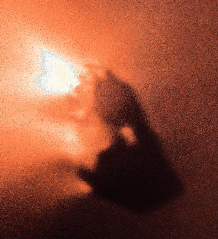
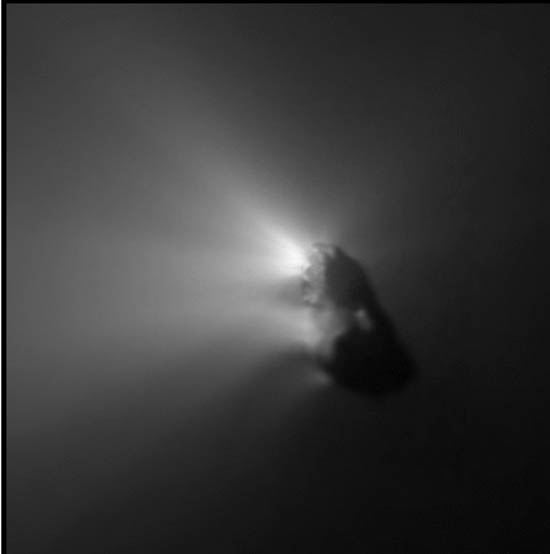
Imagine the fury on the surface of Halley, throwing off dust, gas and water crystals... the same material we encounter in the Orionid meteor shower, the orbital path of Halley that the Earth passes through every late October...
If you could hold a piece of Halley in your hand, it would most likely look like this:
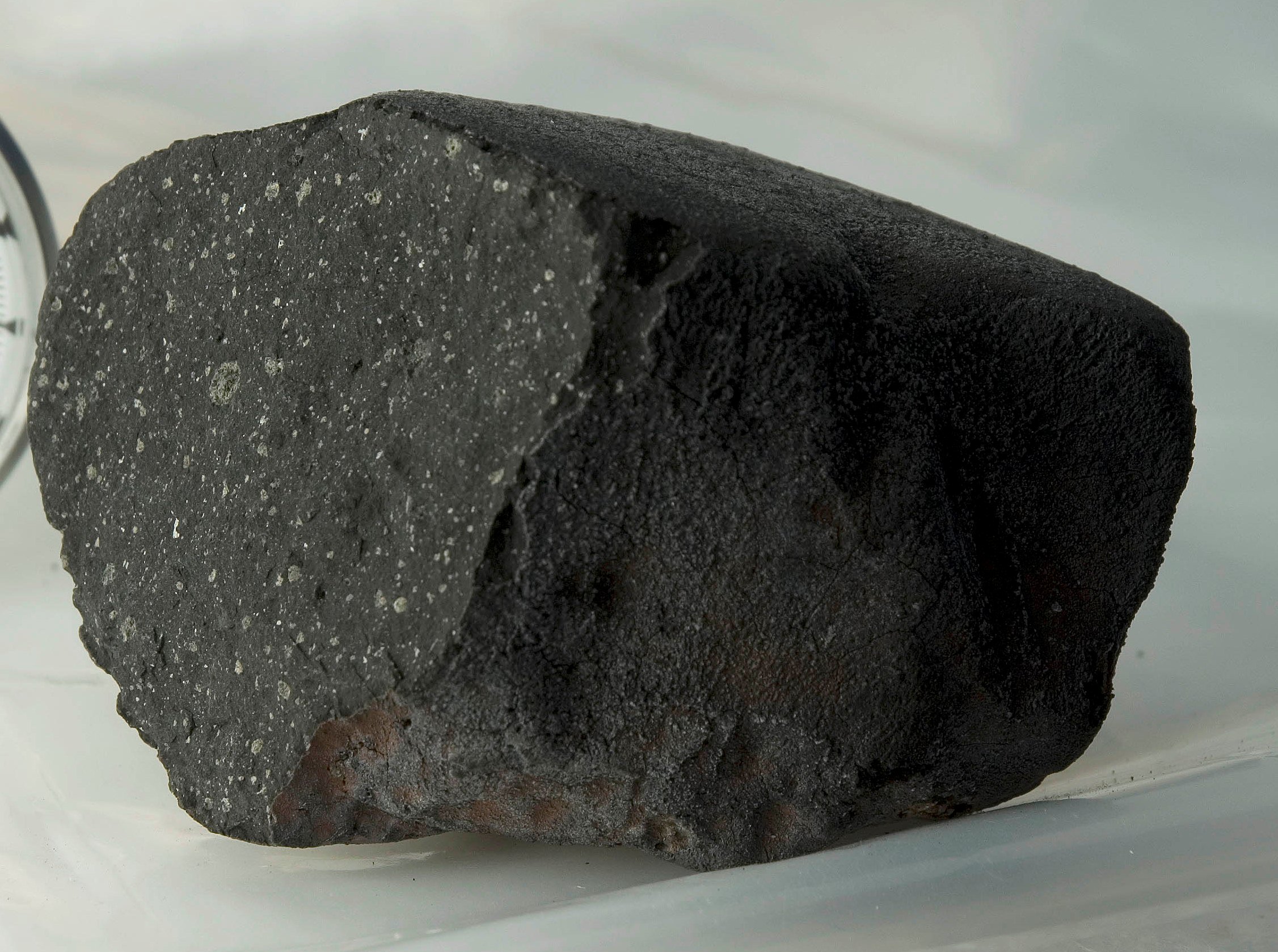
If you were to tighten a grip on this Tagish Lake Meteorite, it would crumble like a cookie. Full of Carbon, Amino Acides, Methane, hydrogen, oxygen, cyanogen and minute traces of iron and nickle.
Source: www2.ess.ucla.edu
Cool, eh?
Comet Halley


Imagine the fury on the surface of Halley, throwing off dust, gas and water crystals... the same material we encounter in the Orionid meteor shower, the orbital path of Halley that the Earth passes through every late October...
If you could hold a piece of Halley in your hand, it would most likely look like this:

If you were to tighten a grip on this Tagish Lake Meteorite, it would crumble like a cookie. Full of Carbon, Amino Acides, Methane, hydrogen, oxygen, cyanogen and minute traces of iron and nickle.
What Does the Image Show?
The image, taken from the Giotto spacecraft near closest encounter in 1986, shows the mantled surface of the nucleus of comet Halley. The sun is to the upper left in this picture. The night-side of the nucleus is visible to the lower right. It is seen in projection against sunlight scattered from the near-nucleus coma. Strong outgassing from a vent is seen at upper left, as well as several fainter vents on the day-side. However, most of the nucleus surface appears to be inactive even when in full sunlight, and this is because of a non-volatile mantle, probably a rubble mantle.
The mantle albedo (reflectivity) is about 4%, indicating a non-icy, probably carbon rich composition.
The lumpy appearance of the nucleus is real. Perhaps the lumps, and the elongated shape...
Source: www2.ess.ucla.edu
Cool, eh?
Tallone
Comet ISON and the Sun are interacting with each other. There has been 4 X class flares from the Sun in the direction of ISON in just as many days. Of the 4 flares 3 of these have been direct hits on ISON.
Good chance for you then to make a prediction based on EC theory.
If you are proposing to link the number and magnitude of solar flares with comet ISON, then state now, how many solar flares are going to happen in the next few weeks, as comet ISON gets nearer the sun, and also as it remains in a close position to the sun shortly after.
Because it seems to me that if you're going to say "4 X class flares from the Sun in the direction of ISON in just as many days" are due to EC theory, then what will you say if comet ISON approaches the sun even more and we go 4 days with no flares at all?
Or is it all post-hoc prediction?
reply to post by alfa1
Why would he ever want to do that as "Eriktheawful" pointed out :-
Nice try.
Why would he ever want to do that as "Eriktheawful" pointed out :-
Please clarify so the mods on here will know whether to leave the thread where it is (scientific discussion, even theoretical discussions) or move it to a more proper place (highly speculative discussions, requiring no proof, IE Skunk Works).
Nice try.
reply to post by vind21
Almost of what I meant . But the cme's were before those comets dived into the sun..
Maybe I'll find it someday thnx any way
Almost of what I meant . But the cme's were before those comets dived into the sun..
Maybe I'll find it someday thnx any way
Here is one for those on the dogwatch tonight.
Take a look at the video below and see what an X flare does to ISON when it slams into it. This is from SECCHI showing both Comet ISON and Comet Encke. This is the X flare that smacked into ISON on the 19th of this month. The action begins at 1:33 into the video. The tail and coma of ISON are stripped, and what you have left is the nucleus.
Points to be taken from this effective video by BPEarthWatch.
1. ISON does not fragment even though the flare is so powerful it rips the coma and tail away!
2. The nucleus is revealed and it looks to be ten times bigger at least than the 5 km most commonly estimated by astronomers working with the DST approach!
3. That nucleus does indeed look round (my observation here and supporting the observation of CGM above)
Now me those SECCHI images of ISON stripped by the X flare provide supporting evidence for the DST.
Ask yourself, would an icy composite withstand that shock? Consider also Comet ISON has withstood the direct impacts of X flares 3 times so far in less than five days.
Looking good for the EC model.
Take a look at the video below and see what an X flare does to ISON when it slams into it. This is from SECCHI showing both Comet ISON and Comet Encke. This is the X flare that smacked into ISON on the 19th of this month. The action begins at 1:33 into the video. The tail and coma of ISON are stripped, and what you have left is the nucleus.
Points to be taken from this effective video by BPEarthWatch.
1. ISON does not fragment even though the flare is so powerful it rips the coma and tail away!
2. The nucleus is revealed and it looks to be ten times bigger at least than the 5 km most commonly estimated by astronomers working with the DST approach!
3. That nucleus does indeed look round (my observation here and supporting the observation of CGM above)
Now me those SECCHI images of ISON stripped by the X flare provide supporting evidence for the DST.
Ask yourself, would an icy composite withstand that shock? Consider also Comet ISON has withstood the direct impacts of X flares 3 times so far in less than five days.
Looking good for the EC model.
edit on 22-11-2013 by Tallone because: (no reason given)
new topics
top topics
-
Trudeau Resigns! Breaking
Mainstream News: 17 hours ago, 29 flags -
January 6th report shows disturbing trend (nobody is shocked)
US Political Madness: 13 hours ago, 22 flags -
The Truth about Migrant Crime in Britain.
Social Issues and Civil Unrest: 15 hours ago, 11 flags -
Let's talk planes.
General Chit Chat: 12 hours ago, 5 flags -
Inexplicable military simulation - virtual reality showdown in the night..
The Gray Area: 14 hours ago, 2 flags
active topics
-
Stuck Farmer And His Queue Jumping Spawn
Rant • 8 • : TimBurr -
Trudeau Resigns! Breaking
Mainstream News • 68 • : MindBodySpiritComplex -
Greatest thing you ever got, or bought?
General Chit Chat • 22 • : 727Sky -
Live updates: Congress meets to certify Trump's presidential election victory
US Political Madness • 19 • : KrustyKrab -
-@TH3WH17ERABB17- -Q- ---TIME TO SHOW THE WORLD--- -Part- --44--
Dissecting Disinformation • 3953 • : 777Vader -
Judge rules president-elect Donald Trump must be sentenced in 'hush money' trial
US Political Madness • 37 • : JadedGhost -
Post A Funny (T&C Friendly) Pic Part IV: The LOL awakens!
General Chit Chat • 7997 • : KrustyKrab -
Meta Llama local AI system is scary good
Science & Technology • 42 • : Arbitrageur -
January 6th report shows disturbing trend (nobody is shocked)
US Political Madness • 57 • : KrustyKrab -
Let's talk planes.
General Chit Chat • 8 • : KrustyKrab

